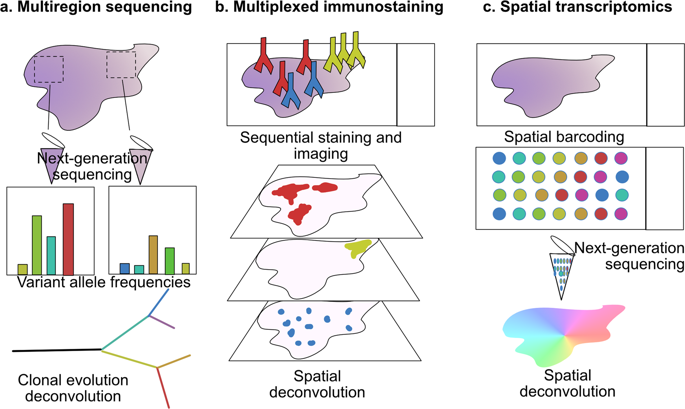Oncogene ( IF 6.9 ) Pub Date : 2019-11-29 , DOI: 10.1038/s41388-019-1127-5 Michalina Janiszewska 1

|
The Cancer Genome Atlas consortium brought us terabytes of information about genetic alterations in different types of human tumors. While many cancer-driver genes have been identified through these efforts, interrogating cancer genomes has also shed new light on tumor complexity. Mutations were found to vary tremendously in their allelic frequencies within the same tumor. Based on those variant allelic frequencies grouping, an estimate of genetically distinct “clones” of cancer cells can be determined for each tumor. It was estimated that 4–8 clones are present in every human tumor. Presence of distinct clones, cells that differ in their genotype and/or phenotype, is one of the roots for the major challenge of effectively curing cancer patients. Any given treatment applied to a heterogeneous mixture of cancer cells will yield distinct responses in different cells and may be ineffective in killing particular clones. Moreover, in highly heterogeneous tumors, stochastically, there is a higher chance of presence of traits, such as point mutations in key receptor tyrosine kinases, that drive drug resistance. Thus, intratumor heterogeneity is like an arsenal, providing a variety of weapons for self-defense against cancer-targeted therapy. However, in this arsenal the supplies are constantly changing, as cancer cells are accumulating new mutations. What is also changing is the battlefield—the tumor microenvironment including all noncancerous cells within the tumor and surrounding tissue, which also contribute to the diversification of cancer’s forces. In order to design more effective therapies that would target this ever-changing landscape, we need to learn more about the two elusive variables that shape the tumor ecosystem: the space—how could we exploit the organization of tumor microenvironment? and the time—how could we predict the changes in heterogeneous tumors?
中文翻译:

肿瘤内异质性的微观世界:癌症进化的时空。
癌症基因组图谱联盟为我们带来了有关不同类型人类肿瘤基因改变的大量信息。虽然通过这些努力已经确定了许多癌症驱动基因,但对癌症基因组的研究也为了解肿瘤的复杂性提供了新的线索。发现同一肿瘤内的突变等位基因频率差异很大。根据这些变异等位基因频率分组,可以确定每个肿瘤的遗传上不同的癌细胞“克隆”的估计。据估计,每个人类肿瘤中都存在 4-8 个克隆。不同克隆、基因型和/或表型不同的细胞的存在是有效治愈癌症患者的主要挑战的根源之一。任何应用于癌细胞异质混合物的给定治疗都会在不同细胞中产生不同的反应,并且可能无法有效杀死特定的克隆。此外,在高度异质性的肿瘤中,随机地存在更高的机会出现导致耐药性的特征,例如关键受体酪氨酸激酶的点突变。因此,肿瘤内异质性就像一个军火库,为癌症靶向治疗的自卫提供了多种武器。然而,随着癌细胞积累新的突变,这个武器库中的供应不断变化。同样发生变化的是战场——肿瘤微环境,包括肿瘤内的所有非癌细胞和周围组织,这也有助于癌症力量的多样化。 为了针对这种不断变化的环境设计更有效的疗法,我们需要更多地了解塑造肿瘤生态系统的两个难以捉摸的变量:空间——我们如何利用肿瘤微环境的组织?以及时间——我们如何预测异质性肿瘤的变化?











































 京公网安备 11010802027423号
京公网安备 11010802027423号